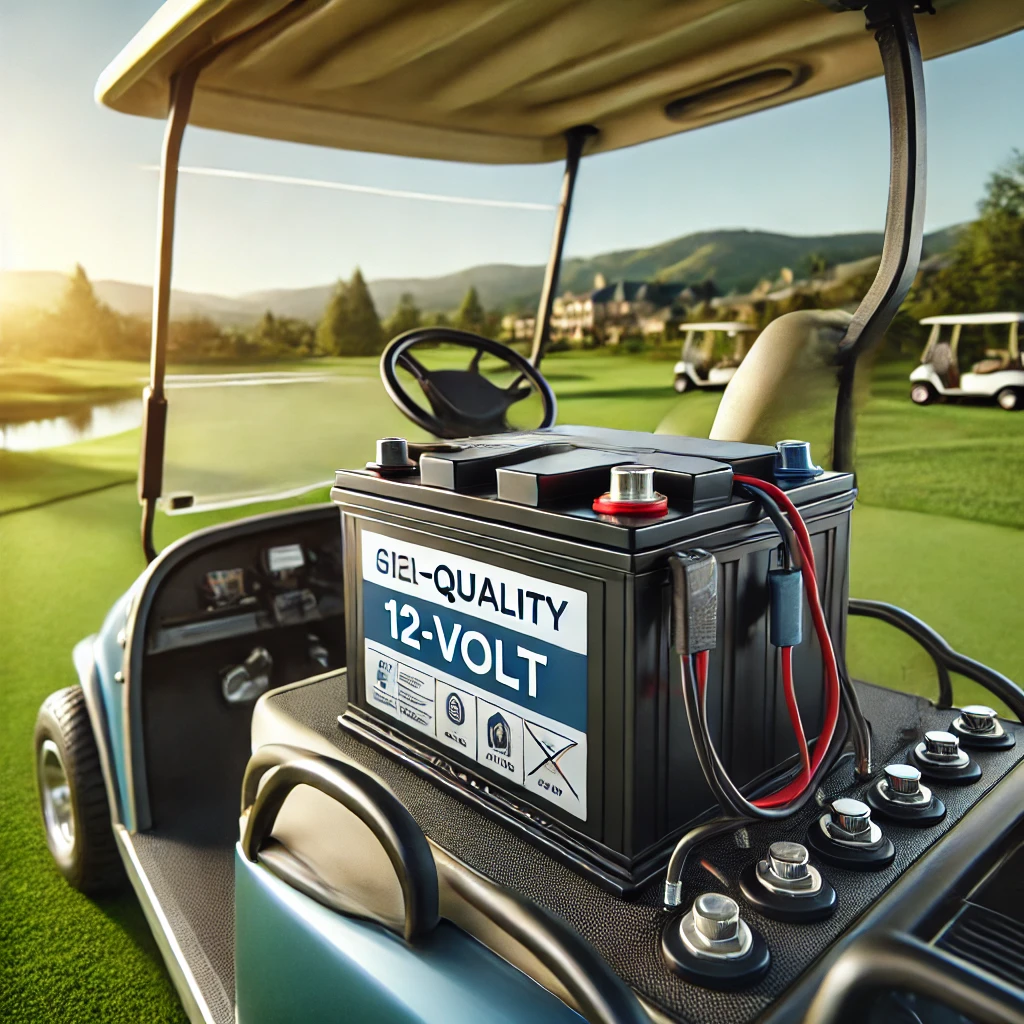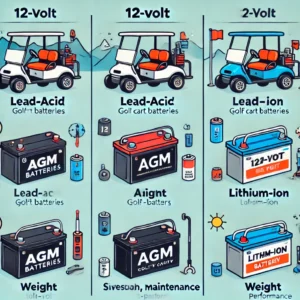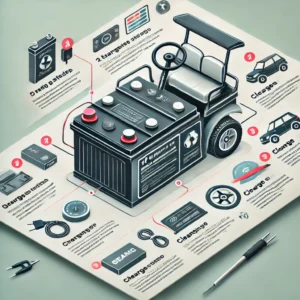Finding Your Perfect Power Source ⚡
Are you tired of being stranded on the golf course with a dead battery? Perhaps you’re looking to upgrade your golf cart’s power system for better performance? Whatever your reason, understanding 12 volt golf cart batteries is essential for anyone who owns or operates these versatile vehicles. As an experienced golf cart enthusiast, I’ve spent years testing various battery configurations, and I’m here to share everything you need to know about these crucial power components.
The world of 12 volt golf cart batteries can seem overwhelming at first. With numerous brands, specifications, and technical jargon, finding the right power solution often feels like navigating a complex maze. However, selecting the proper battery isn’t just about keeping your cart moving—it’s about optimizing performance, extending range, and ensuring reliability when you need it most.
In this comprehensive guide, we’ll explore everything from understanding basic battery specifications to comparing top-rated 12 volt golf cart batteries available on the market today. Additionally, we’ll dive into maintenance tips, installation procedures, and troubleshooting advice to help you get the most out of your investment.
Understanding 12 Volt Golf Cart Battery Basics
Before diving into specific recommendations, let’s establish a solid foundation of knowledge about 12 volt golf cart batteries. Traditionally, most golf carts operated on 36V or 48V systems using six 6-volt batteries or six 8-volt batteries connected in series. However, the 12-volt configuration has gained popularity for several compelling reasons.
Why Choose 12 Volt Golf Cart Batteries?
✅ Simplified Configuration: Using 12-volt batteries means fewer units to maintain and replace (three 12V batteries for a 36V system versus six 6V batteries).
✅ Versatility: Many 12-volt batteries can serve multiple purposes, allowing interchangeability between your golf cart and other vehicles or equipment.
✅ Weight Distribution: Depending on the model, 12-volt batteries might offer better weight distribution in your cart.
✅ Availability: 12-volt batteries are widely available and often easier to find than specialized 6-volt or 8-volt golf cart batteries.
However, it’s important to note that 12-volt batteries typically have a shorter lifespan in deep-cycle applications compared to their 6-volt counterparts. This is because 12-volt batteries generally have thinner plates to accommodate more cells in the same case size.
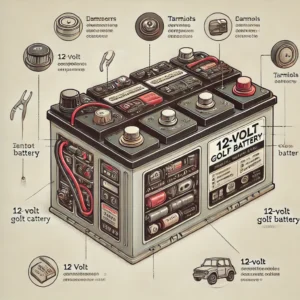
Key Specifications to Consider
When shopping for 12 volt golf cart batteries, you’ll encounter several important specifications. Understanding these will help you make an informed decision:
- Amp-Hour (Ah) Rating: This indicates how much energy the battery can store. Higher Ah ratings mean longer run times between charges. For golf carts, look for batteries with at least 100Ah capacity.
- Reserve Capacity (RC): Measured in minutes, this tells you how long the battery can deliver a sustained current (usually 25 amps) before dropping below a usable voltage. A higher RC means better performance during extended use.
- Cold Cranking Amps (CCA): While more relevant for automotive starting batteries, this can still be useful to know. It measures the battery’s ability to deliver current in cold conditions.
- Cycle Life: This represents how many charge-discharge cycles the battery can handle before its capacity significantly deteriorates. Quality deep-cycle batteries should offer at least 500-800 cycles.
- Physical Dimensions: Ensure the battery will fit in your golf cart’s battery compartment. Common group sizes for 12 volt golf cart batteries include Group 27, Group 31, and 4D.
Types of 12 Volt Golf Cart Batteries
Not all 12-volt batteries are created equal. For golf cart applications, you’ll generally be choosing between several distinct technologies:
Flooded Lead-Acid Batteries
These traditional batteries remain popular due to their affordability and reliability.
Pros:
- Lower initial cost
- Proven technology
- Widely available
- Recyclable
Cons:
- Require regular maintenance (water addition and terminal cleaning)
- Risk of acid spills
- Must remain upright
- Shorter lifespan than premium alternatives
- Performance decreases in cold weather
AGM (Absorbent Glass Mat) Batteries
AGM technology represents a significant upgrade over flooded lead-acid batteries.
Pros:
- Maintenance-free design
- Spill-proof construction
- Better performance in cold weather
- Can be mounted in various positions
- Slower self-discharge rate
- Faster charging capability
Cons:
- Higher cost than flooded lead-acid
- Sensitive to overcharging
- Generally heavier than flooded batteries of equivalent capacity
Gel Batteries
Gel batteries use a silica additive to thicken the electrolyte, turning it into a gel-like substance.
Pros:
- Completely sealed and maintenance-free
- Excellent deep-cycle performance
- Very low self-discharge rate
- Resistant to vibration
- No risk of acid spills
Cons:
- Most expensive lead-acid option
- Require specialized chargers
- Limited availability
- Heavy weight
Lithium Iron Phosphate (LiFePO4) Batteries
The newest technology represents the premium tier of golf cart batteries.
Pros:
- Significantly lighter weight (often 70% lighter than lead-acid)
- Much longer cycle life (2000-5000 cycles)
- Maintenance-free operation
- Faster charging
- Better performance in extreme temperatures
- No voltage sag during discharge
Cons:
- Highest initial investment
- May require battery management system
- Some golf cart chargers need modification
Top 12 Volt Golf Cart Batteries Available Today
After extensive testing and research, here are my recommendations for the best 12 volt golf cart batteries currently available:
Best Overall: Mighty Max ML125-12 12V 125AH SLA Battery
This sealed lead-acid battery offers an excellent balance of performance, reliability, and value. With a 125Ah capacity, it provides ample power for standard golf cart applications while remaining reasonably priced.
Key Features:
- 125Ah capacity
- Maintenance-free design
- Spill-proof construction
- Excellent vibration resistance
- Can be mounted in any position
- 1-year warranty
Best Premium Option: Battle Born 12V 100Ah LiFePO4 Deep Cycle Battery
If budget isn’t a concern, this lithium iron phosphate battery delivers exceptional performance and longevity. Though expensive upfront, its 3000+ cycle life means it will outlast several sets of lead-acid batteries.
Key Features:
- 100Ah capacity
- Incredible 3000-5000 cycle life
- Built-in battery management system
- 10-year warranty
- Lightweight design (29 lbs)
- Safe LiFePO4 chemistry
Best Budget Choice: Universal Power Group UB121000 12V 100AH SLA Battery
For golf cart owners seeking affordability without sacrificing quality, this 100Ah AGM battery delivers reliable performance at a competitive price point.
Key Features:
- 100Ah capacity
- Maintenance-free AGM design
- Good deep cycle performance
- Versatile mounting options
- Reasonable cycle life (200-300 cycles)
Best for Extreme Weather: VMAXTANKS MR127 12V 100Ah AGM Battery
If you live in an area with temperature extremes, this military-grade AGM battery offers excellent performance in both hot and cold conditions.
Key Features:
- 100Ah capacity
- Military-grade plates
- Exceptional temperature tolerance
- 8-10 year float service life
- Custom built for deep cycle applications
- Maintenance-free operation
Comparison Table: Top 12 Volt Golf Cart Batteries
| Battery Model | Type | Capacity | Weight | Cycle Life | Price Range | Best For |
|---|---|---|---|---|---|---|
| Mighty Max ML125-12 | AGM | 125Ah | 63.9 lbs | 200-300 | $$ | Overall Value |
| Battle Born LiFePO4 | Lithium | 100Ah | 29 lbs | 3000-5000 | $$$$ | Premium Performance |
| UB121000 | AGM | 100Ah | 64 lbs | 200-300 | $ | Budget-Conscious |
| VMAXTANKS MR127 | AGM | 100Ah | 68 lbs | 300-400 | $$$ | Extreme Conditions |
| Weize 12V 100AH Deep Cycle AGM | AGM | 100Ah | 60 lbs | 200-300 | $$ | Reliability |
Ready to upgrade your golf cart’s power system? Check out these top-rated batteries on Amazon now and experience the difference quality power makes! Your cart will thank you with improved performance and reliability.
How to Install 12 Volt Golf Cart Batteries
Installing 12 volt golf cart batteries is a relatively straightforward process that most owners can handle without professional help. Here’s a step-by-step guide:
Tools You’ll Need:
- Socket set or wrenches
- Battery terminal cleaner
- Protective gloves
- Safety glasses
- Battery terminal protectant spray
Installation Steps:
- Safety First: Wear protective gloves and eyewear. Turn off all accessories and the main switch if your cart has one.
- Remove Old Batteries: Disconnect the negative terminal first, then the positive. Take note of how the batteries are connected to ensure proper replacement.
- Clean Battery Compartment: Remove any corrosion or debris from the battery tray and cables.
- Place New Batteries: Position the new 12-volt batteries in the compartment, ensuring they fit securely.
- Connect in Series: For a typical 36V golf cart, connect three 12V batteries in series. This means connecting the positive terminal of the first battery to the negative terminal of the second, and so on.
- Secure Final Connections: Connect the main positive and negative cables to complete the circuit. Ensure all connections are tight but not overtightened.
- Apply Terminal Protectant: Spray a battery terminal protectant to prevent future corrosion.
- Verify Voltage: Use a multimeter to confirm your system is producing the expected voltage (36V for a three-battery setup).
Common Installation Mistakes to Avoid:
❌ Incorrect Series Connection: Ensure you’re connecting positive to negative between batteries for series configuration.
❌ Loose Connections: Tighten all terminals appropriately to prevent arcing and resistance.
❌ Mixing Battery Types: For optimal performance, use identical batteries in your system.
❌ Forgetting to Check Compatibility: Verify that your new batteries match the voltage requirements of your golf cart controller.
Maximizing 12 Volt Golf Cart Battery Life ️
The lifespan of your 12 volt golf cart batteries largely depends on how well you maintain them. Follow these best practices to get the most out of your investment:
Charging Best Practices
✅ Use the Right Charger: Always use a charger specifically designed for your battery type. Using an incompatible charger can significantly reduce battery life.
✅ Charge After Each Use: Even short trips warrant recharging. This prevents sulfation in lead-acid batteries.
✅ Avoid Deep Discharges: Try not to discharge lead-acid batteries below 50% capacity. For lithium batteries, you can safely go lower.
✅ Complete the Charging Cycle: Allow the charger to complete its full cycle before disconnecting.
✅ Check Voltage Regularly: Monitor battery voltage to ensure it’s maintaining proper levels.
Maintenance Schedule
For flooded lead-acid batteries:
- Weekly: Check water levels and add distilled water if necessary
- Monthly: Clean terminals and check for corrosion
- Quarterly: Perform equalization charging (if recommended by manufacturer)
For AGM and Gel batteries:
- Monthly: Check terminals for corrosion
- Quarterly: Clean battery tops and terminals
For Lithium batteries:
- Monthly: Check terminals for corrosion
- Annually: Update firmware in battery management system (if applicable)
Storage Tips
If you’re storing your golf cart for extended periods:
✅ Fully Charge Before Storage: This is especially important for lead-acid batteries.
✅ Disconnect Batteries: Remove the main connections to prevent parasitic drain.
✅ Store in Climate-Controlled Space: Extreme temperatures accelerate self-discharge.
✅ Periodic Maintenance Charging: Even in storage, check and recharge lead-acid batteries every 4-6 weeks.

Troubleshooting Common 12 Volt Golf Cart Battery Issues ⚠️
Even with proper maintenance, you might encounter issues with your 12 volt golf cart batteries. Here’s how to diagnose and address common problems:
Reduced Range
Possible Causes:
- Battery aging
- Undercharging
- Tire pressure issues
- Excess weight
- Controller problems
Solutions:
- Test individual battery voltages under load
- Ensure charger is functioning properly
- Check tire pressure
- Evaluate if cart is carrying excess weight
Slow Acceleration
Possible Causes:
- Battery voltage sag
- Poor connections
- Controller limitations
- Motor issues
Solutions:
- Check battery voltage under acceleration
- Clean and tighten all electrical connections
- Inspect motor brushes and commutator
Charger Problems
Possible Causes:
- Faulty charger
- Incorrect charger settings
- Poor AC power supply
- Battery sulfation
Solutions:
- Verify charger output voltage
- Check AC power source
- Inspect charger plug and receptacle
- Consider desulfation for lead-acid batteries
Uneven Battery Performance
Possible Causes:
- One weak battery in the bank
- Imbalanced charging
- Different battery ages in the same bank
Solutions:
- Test each battery individually
- Replace the entire bank if one battery fails
- Never mix new and old batteries
Upgrading Your Golf Cart with 12-Volt Batteries: What to Consider
If you’re switching from 6-volt or 8-volt batteries to a 12-volt configuration, keep these factors in mind:
Weight Distribution
12-volt batteries typically result in a different weight distribution in your cart. This might affect handling and performance, particularly on slopes or uneven terrain. Consider adding counterweights if necessary.
Space Considerations
Three 12-volt batteries generally take up less space than six 6-volt batteries. This might allow for additional accessories or storage in your cart.
Controller Compatibility
Most golf cart controllers work with various battery configurations as long as the total voltage matches requirements. However, some more sophisticated controllers might need reprogramming for optimal performance.
Charger Requirements
Ensure your charger is compatible with your new battery configuration. Many modern golf cart chargers are adjustable, but older models might require replacement.
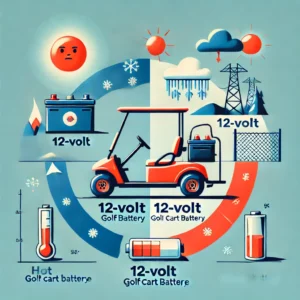
Environmental and Safety Considerations
Environmental Impact
Lead-acid batteries contain hazardous materials that must be properly recycled. Fortunately, these batteries are among the most recycled products in America, with recovery rates exceeding 99%. When purchasing new batteries, many retailers offer recycling programs for your old units.
Lithium batteries have different environmental considerations. While they contain fewer toxic materials than lead-acid batteries, they require specialized recycling processes. Always ensure proper disposal through certified recycling centers.
Safety Precautions
⚠️ Venting: Lead-acid batteries produce hydrogen gas during charging. Always charge in well-ventilated areas.
⚠️ Acid Exposure: Wear appropriate protection when handling flooded lead-acid batteries to prevent acid burns.
⚠️ Short Circuit Prevention: Remove metallic jewelry before working with batteries and use insulated tools.
⚠️ Fire Risk: Keep batteries away from open flames and sparks, particularly during charging.
⚠️ Lifting Safety: 12 volt golf cart batteries are heavy. Use proper lifting techniques or get assistance.
FAQs About 12 Volt Golf Cart Batteries ❓
Q: How long do 12 volt golf cart batteries typically last?
A: With proper maintenance, lead-acid 12 volt golf cart batteries typically last 3-5 years. AGM and Gel variants might extend to 5-7 years, while lithium batteries can last 8-10 years or longer.
Q: Can I mix different types of 12-volt batteries in my golf cart?
A: No, mixing different battery types, brands, or ages can cause significant problems. Always replace your entire battery bank with matching units.
Q: How often should I charge my 12 volt golf cart batteries?
A: Ideally, charge after each use, regardless of how short the trip was. This is especially important for lead-acid batteries, which suffer from sulfation when left in a partially discharged state.
Q: Are lithium batteries worth the higher cost for golf carts?
A: For many users, yes. Though the initial investment is higher, the longer lifespan, improved performance, reduced weight, and maintenance-free operation often justify the cost over time. However, budget-conscious users who don’t mind maintenance can still get excellent service from quality lead-acid batteries.
Q: Can I upgrade my 36V golf cart to 48V using 12-volt batteries?
A: While technically possible by adding a fourth 12V battery, this requires significant modifications to your controller, motor, and other electrical components. It’s not generally recommended unless you’re prepared for a comprehensive system upgrade.
Q: How do I know when it’s time to replace my 12 volt golf cart batteries?
A: Watch for these signs: significantly reduced range (less than 70% of original), inability to hold a charge, physical deformation or damage, excessive heat during charging, or voltage readings that remain unstable after charging.
Conclusion: Powering Your Way to Better Performance ⚡
Selecting the right 12 volt golf cart batteries is an investment in your vehicle’s performance, reliability, and longevity. Whether you opt for budget-friendly flooded lead-acid batteries or premium lithium technology, understanding your options and maintaining your batteries properly will ensure you get the most from your investment.
Remember that battery performance directly impacts nearly every aspect of your golf cart experience—from acceleration and top speed to range and reliability. By choosing quality 12-volt batteries that match your specific needs and usage patterns, you’ll enjoy better performance and fewer headaches down the road.
When making your selection, consider your typical usage, budget, maintenance preferences, and environmental conditions. Each factor plays an important role in determining which battery type and model will serve you best.
Ready to transform your golf cart’s performance with new 12-volt batteries? Click any of the product links in this guide to find the perfect power solution for your needs. Don’t let battery problems keep you off the course—upgrade today and enjoy the difference quality power makes!
More FQAs:
❓ What are the advantages of using 12 volt batteries in golf carts?
✅ 12 volt batteries simplify configuration by reducing the number of batteries needed, offer versatility for use in various applications, and are widely available...
❓ How do I determine the appropriate number of 12 volt batteries for my golf cart?
✅ The number of 12 volt batteries required depends on your golf cart's voltage system; for example, a 48-volt system typically uses four 12-volt batteries...
❓ What maintenance is required for 12 volt golf cart batteries?
✅ Maintenance varies by battery type; flooded lead-acid batteries require regular watering and terminal cleaning, while AGM and lithium-ion batteries are generally maintenance-free...
❓ How does battery type affect the lifespan of a 12 volt golf cart battery?
✅ Lithium-ion batteries typically offer a longer lifespan, handling up to 5,000 charge cycles, whereas lead-acid batteries usually manage around 1,000 cycles...
❓ Can I mix different types of 12-volt batteries in my golf cart?
✅ Mixing different types or ages of batteries is not recommended, as it can lead to uneven charging and reduced overall performance...
Recommended for You:
- Unlock Your Golf Potential: The Ultimate Guide to Square Golf Launch Monitors in 2025
- The Ultimate Guide to Golf Pencils: Small Tools with Big Impact (2025)️
- Club Car Golf Carts: The Best 2025 Buying Guide | Top Models, Maintenance & Expert Tips
Disclaimer: This article contains affiliate links. If you purchase products through these links, we may earn a small commission at no additional cost to you.

